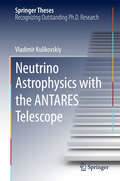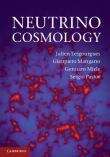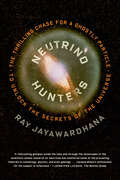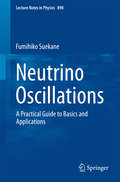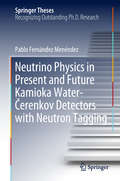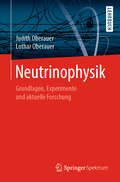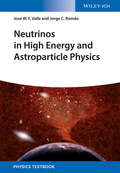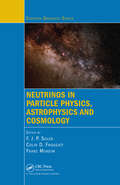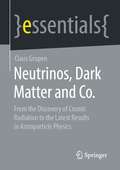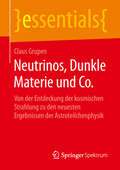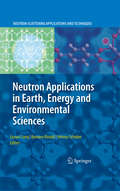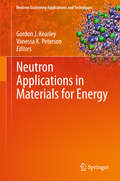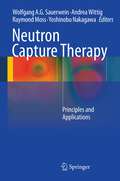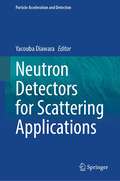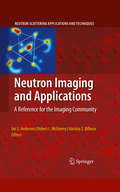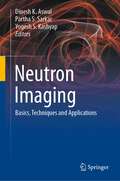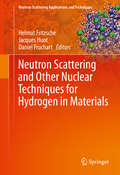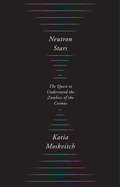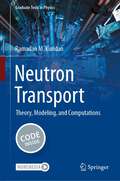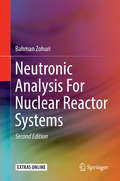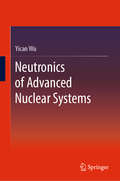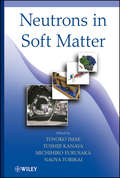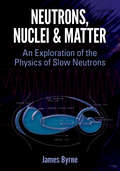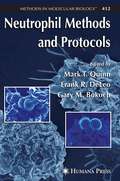- Table View
- List View
Neutrino Astrophysics with the ANTARES Telescope
by Vladimir KulikovskiyThis thesis is devoted to ANTARES, the first underwater neutrino telescope in the Mediterranean sea. As the main scientific analysis, a search for high-energy neutrino emission from the region of the Fermi bubbles has been performed using data from the ANTARES detector. A method for the background estimation using off-zones has been developed specially for this measurement. A new likelihood for the limits calculation which treats both observations in the on-zone and in the off-zone in the similar way and also includes different systematic uncertainties has been constructed. The analysis of 2008-2011 ANTARES data yielded a 1. 2 σ excess of events in the Fermi bubble regions, compatible with the no-signal hypothesis. For the optimistic case of no energy cutoff in the flux, the upper limit is within a factor of three of the prediction of the purely hadronic model based on the measured gamma-ray flux. The sensitivity improves as more data are accumulated (more than 65% gain in the sensitivity is expected once 2012-2016 data are added to the analysis).
Neutrino Cosmology
by Julien Lesgourgues Gianpiero Mangano Gennaro Miele Sergio PastorThe role that neutrinos have played in the evolution of the Universe is the focus of one of the most fascinating research areas that has stemmed from the interplay between cosmology, astrophysics and particle physics. In this self-contained book, the authors bring together all aspects of the role of neutrinos in cosmology, spanning from leptogenesis to primordial nucleosynthesis, their role in CMB and structure formation, to the problem of their direct detection. The book starts by guiding the reader through aspects of fundamental neutrino physics, such as the standard cosmological model and the statistical mechanics in the expanding Universe, before discussing the history of neutrinos in chronological order from the very early stages until today. This timely book will interest graduate students and researchers in astrophysics, cosmology and particle physics, who work with either a theoretical or experimental focus.
Neutrino Hunters: The Thrilling Chase for a Ghostly Particle to Unlock the Secrets of the Universe
by Ray JayawardhanaWinner of the Canadian Science Writers Association Science in Society Book AwardOne of the Best Physics Books of 2013, Cocktail Party Physics Blog, Scientific AmericanDetective thriller meets astrophysics in this adventure into neutrinos and the scientists who pursue themThe incredibly small bits of matter we call neutrinos may hold the secret to why antimatter is so rare, how mighty stars explode as supernovae, what the universe was like just seconds after the big bang, and even the inner workings of our own planet.For more than eighty years, adventurous minds from around the world have been chasing these ghostly particles, trillions of which pass through our bodies every second. Extremely elusive and difficult to pin down, neutrinos are not unlike the brilliant and eccentric scientists who doggedly pursue them.In Neutrino Hunters, the renowned astrophysicist and award-winning writer Ray Jayawardhana takes us on a thrilling journey into the shadowy world of neutrinos and the colorful lives of those who seek them. Demystifying particle science along the way, Jayawardhana tells a detective story with cosmic implications—interweaving tales of the sharp-witted theorist Wolfgang Pauli; the troubled genius Ettore Majorana; the harbinger of the atomic age Enrico Fermi; the notorious Cold War defector Bruno Pontecorvo; and the dynamic dream team of Marie and Pierre Curie. Then there are the scientists of today who have caught the neutrino bug, and whose experimental investigations stretch from a working nickel mine in Ontario to a long tunnel through a mountain in central Italy, from a nuclear waste site in New Mexico to a bay on the South China Sea, and from Olympic-size pools deep underground to a gigantic cube of Antarctic ice—called, naturally, IceCube.As Jayawardhana recounts a captivating saga of scientific discovery and celebrates a glorious human quest, he reveals why the next decade of neutrino hunting will redefine how we think about physics, cosmology, and our lives on Earth.
Neutrino Oscillations
by Fumihiko SuekaneNeutrino oscillation (N. O. ) is the only firm evidence of the physics beyond the Standard Model of particle physics and is one of the hottest topics in elementary particle physics today. This book focuses on the N. O. , from its history to the future prospects, from the basic theories to the experiments. Various phenomena of N. O. are described intuitively with thorough explanations of the fundamental physics behind well-known formulations. For example, while many textbooks start with a discussion of the mixing matrix, this book stresses that N. O. is caused by the transition amplitudes between different neutrino flavors, and that the purpose of N. O. experiments is to measure transition amplitudes and think of its origin. The current understanding of neutrino oscillation is also summarized using the most up-to-date measurements, including the recently measured neutrino mixing angle θ13, and the future prospects of N. O. studies are described as well. The level of this book makes it a bridge between introductory textbooks and scientific papers.
Neutrino Physics (Series in Particle Physics, Cosmology and Gravitation)
by Kai ZuberWhen Kai Zuber’s pioneering text on neutrinos was published in 2003, the author correctly predicted that the field would see tremendous growth in the immediate future. In that book, Professor Zuber provided a comprehensive self-contained examination of neutrinos, covering their research history and theory, as well as their application to particle physics, astrophysics, nuclear physics, and the broad reach of cosmology; but now to be truly comprehensive and accurate, the field’s seminal reference needs to be revised and expanded to include the latest research, conclusions, and implications. Revised as needed to be equal to the research of today, Neutrino Physics, Third Edition delves into neutrino cross-sections, mass measurements, double beta decay, solar neutrinos, neutrinos from supernovae, and high-energy neutrinos, as well as entirely new experimental results in the context of theoretical models. Written to be accessible to graduate students and readers from diverse backgrounds, this edition, like the first, provides both an introduction to the field as well as the information needed by those looking to make their own contributions to it. And like the second edition, it whets the researcher’s appetite, going beyond certainty to pose those questions that still need answers. Features Presents the only single-author comprehensive text on neutrino physics Includes experimental and theoretical particle physics and examines solar neutrinos and astroparticle implications Offers details on new developments and recent experiments
Neutrino Physics in Present and Future Kamioka Water‐Čerenkov Detectors with Neutron Tagging (Springer Theses)
by Pablo Fernández MenéndezThis book discusses the upgrade of the Super-Kamiokande (SK) detector, which consists in the addition of a salt of gadolinium into the detector’s water, the goal being to endow it with a very high-efficiency ability to detect neutrons: the SuperK-Gd project. This will substantially improve the scientific value of the SK detector because, among others, neutron production is related to the matter–antimatter character of the interacting neutrino. In this book the authors develop several procedures for maximizing the impact of neutron tagging in various physics analyses involving a broad range of neutrino energy. They thoroughly study the impact of new backgrounds introduced by Gd in key physics analyses, most remarkably including the search for the Diffuse Supernova Neutrino Background. At GeV energies, the neutron tagging improvements are evaluated by performing a complete neutrino oscillation sensitivity study using atmospheric and long baseline neutrinos, with a focus on the neutrino mass hierarchy and the leptonic CP violation. In order to prove the relevance of neutron tagging with the available data, the authors apply the neutron-tagging tools developed here to the 4th phase of the SK detector, which is already capable of detecting a low fraction of the neutrons produced through hydrogen-neutron captures. A global oscillation analysis of the SK’s atmospheric neutrino data is also conducted.
Neutrinophysik: Grundlagen, Experimente und aktuelle Forschung
by Lothar Oberauer Judith OberauerDas vorliegende Buch bietet dem Leser einen Überblick über die Physik der Neutrinos, der leichtesten Fermionen im Standardmodell der Teilchenphysik. Neben den Grundlagen und der theoretischen Beschreibung beleuchten die Autoren aktuelle Forschung und offene Fragestellungen zur Neutrinophysik. Die Autoren besprechen die Rolle dieser Teilchen in Kosmologie und Astrophysik, gehen auf moderne Neutrino-Experimente ein und erklären die aktuellsten Ergebnisse verständlich. Grundlagen zum Verständnis des Buches sind Kenntnisse der klassischen Physik und Grundkenntnisse der Quantenmechanik - Vorkenntnisse in der Kern- und Teilchenphysik schaden nicht, sind aber auch nicht unbedingt nötig. Das Buch richtet sich an Bacheloranden, Master-Studierende, Doktorandinnen und Doktoranden und Postdocs, die im Bereich der theoretischen oder experimentellen Neutrinophysik ihre Abschlussarbeit schreiben und forschen. Aus dem Inhalt: Neutrinos im Standardmodell Neutrinooszillationen Experimente zu Neutrinooszillationen Status von Neutrinooszillationen und offene Fragen Neutrinos in Astrophysik und Kosmologie
Neutrinos in High Energy and Astroparticle Physics
by José Wagner Valle Jorge RomaoThis self-contained modern textbook provides a modern description of the Standard Model and its main extensions from the perspective of neutrino physics. In particular it includes a thorough discussion of the varieties of seesaw mechanism, with or without supersymmetry. It also discusses schemes where neutrino mass arises from lighter messengers, which might lie within reach of the world's largest particle accelerator, the Large Hadron Collider. Throughout the text, the book stresses the role of neutrinos due to the fact that neutrino properties may serve as a guide to the correct model of unification, hence for a deeper understanding of high energy physics, and because neutrinos play an important role in astroparticle physics and cosmology. Each chapter includes summaries and set of problems, as well as further reading.
Neutrinos in Particle Physics, Astrophysics and Cosmology
by F. J. P. Soler Colin D. Froggatt Franz MuheimUp to date and comprehensive in its coverage, Neutrinos in Particle Physics, Astrophysics and Cosmology reviews the whole landscape of neutrino physics, from state-of-the-art experiments to the latest phenomenological and theoretical developments to future advances.With contributions from internationally recognized leaders in the field, the book co
Neutrinos, Dark Matter and Co.: From the Discovery of Cosmic Radiation to the Latest Results in Astroparticle Physics
by Claus GrupenIn this essential, Claus Grupen discusses astroparticle physics in a short historical outline and describes the latest results without going into mathematical detail. As an introduction to this new field of research, he gives an overview of what happens in the sky, between stars and between galaxies. By now, many things are quite well understood, but with every solution found, new questions arise - the author also deals with this spectrum of questions with some answers. Today, astroparticle physics is an active, interdisciplinary field of research that includes and combines astronomy, cosmic rays and elementary particle physics.This Springer essential is a translation of the original German 1st edition essentials, Neutrinos, Dunkle Materie und Co. by Claus Grupen, published by Springer Fachmedien Wiesbaden GmbH, part of Springer Nature in 2021.The translation was done with the help of artificial intelligence (machine translation by the service DeepL.com). A subsequent human revision was done primarily in terms of content, so that the book will read stylistically differently from a conventional translation. Springer Nature works continuously to further the development of tools for the production of books and on the related technologies to support the authors
Neutrinos, Dunkle Materie und Co.: Von der Entdeckung der kosmischen Strahlung zu den neuesten Ergebnissen der Astroteilchenphysik (essentials)
by Claus GrupenClaus Grupen erörtert in diesem essential in einem kurzen historischen Abriss die Astroteilchenphysik und beschreibt die neuesten Resultate, ohne ins mathematische Detail zu gehen. Als Einstieg in dieses neue Forschungsgebiet verstanden, gibt er einen Überblick darüber, was sich am Himmel, zwischen den Sternen und zwischen den Galaxien abspielt. Es ist inzwischen schon vieles recht gut verstanden, aber mit jeder gefundenen Lösung tun sich auch neue Fragen auf – auf dieses Fragenspektrum mit einigen Antworten geht der Autor ebenfalls ein. Heute ist die Astroteilchenphysik ein aktives, interdisziplinäres Forschungsgebiet, das Astronomie, kosmische Strahlung und Elementarteilchenphysik umfasst und vereinigt.
Neutron Applications in Earth, Energy and Environmental Sciences
by Romano Rinaldi Liyuan Liang Helmut SchoberNeutron Applications in Earth, Energy and Environmental Sciences offers a comprehensive overview of the wide ranging applications of neutron scattering techniques to elucidate the fundamental materials properties at the nano-, micro- and meso-scale, which underpin research in the related fields of Earth, Energy and Environmental Sciences. Introductions to neutron scattering fundamentals and instrumentation are paired with a thorough review of the applications to a large variety of scientific and technological problems, written through the direct experience of leading scientists in each field. Tailored to a wide audience, this volume provides the novice with an inspiring introduction and stimulates the expert to consider these non-conventional problem solving techniques in his/her field of interest. Earth and environmental scientists, engineers, researchers and graduate students involved with materials science will find Neutron Applications in Earth, Energy and Environmental Sciences a valuable ready-to-use reference.
Neutron Applications in Materials for Energy
by Gordon J. Kearley Vanessa K. PetersonNeutron Applications in Materials for Energy collects results and conclusions of recent neutron-based investigations of materials that are important in the development of sustainable energy. Chapters are authored by leading scientists with hands-on experience in the field, providing overviews, recent highlights, and case-studies to illustrate the applicability of one or more neutron-based techniques of analysis. The theme follows energy production, storage, and use, but each chapter, or section, can also be read independently, with basic theory and instrumentation for neutron scattering being outlined in the introductory chapter. Whilst neutron scattering is extensively used to understand properties of condensed matter, neutron techniques are exceptionally-well suited to studying how the transport and binding of energy and charge-carrying molecules and ions are related to their dynamics and the material's crystal structure. These studies extend to in situ and in operando in some cases. The species of interest in leading energy-technologies include H2, H+, and Li+ which have particularly favourable neutron-scattering properties that render these techniques of analysis ideal for such studies and consequently, neutron-based analysis is common-place for hydrogen storage, fuel-cell, catalysis, and battery materials. Similar research into the functionality of solar cell, nuclear, and CO2 capture/storage materials rely on other unique aspects of neutron scattering and again show how structure and dynamics provide an understanding of the material stability and the binding and mobility of species of interest within these materials. Scientists and students looking for methods to help them understand the atomic-level mechanisms and behaviour underpinning the performance characteristics of energy materials will find Neutron Applications in Materials for Energy a valuable resource, whilst the wider audience of sustainable energy scientists, and newcomers to neutron scattering should find this a useful reference.
Neutron Capture Therapy
by Andrea Wittig Raymond Moss Wolfgang A.G. Sauerwein Yoshinobu NakagawaNeutron capture therapy (NCT) is based on the ability of the non-radioactive isotope boron-10 to capture thermal neutrons with very high probability and immediately to release heavy particles with a path length of one cell diameter, which in principle allows for tumor cell-selective high-LET particle radiotherapy. This book provides a comprehensive summary of the progress made in NCT in recent years. Individual sections cover all important aspects, including neutron sources, boron chemistry, drugs for NCT, dosimetry, and radiation biology. The use of NCT in a variety of malignancies and also some non-malignant diseases is extensively discussed. NCT is clearly shown to be a promising modality at the threshold of wider clinical application. All of the chapters are written by experienced specialists in language that will be readily understood by all participating disciplines.
Neutron Detectors for Scattering Applications (Particle Acceleration and Detection)
by Yacouba DiawaraThis book covers the most common neutron detectors used in neutron scattering facilities and all of those in use at Oak Ridge National Lab. It starts describing the facilities, instruments and the critical detector parameters needed by various instruments. Then the key components of the 3He-based linear position-sensitive detectors as well as on their electronics, which require particular attention to signal processing and noise reduction, are introduced. One chapter is dedicated to the 3He alternatives where scintillators play a critical role. It also covers emerging neutron detection technologies including semiconductors, vacuum-based devices and their associated readouts, which will be required in the future for high rate and high-resolution neutron detectors.The authors explain the logic behind the choice of materials as well as the various constraints that neutron detectors must respect to be useful. Some of these constraints, such as efficiency and gamma-ray sensitivity are common to all neutron counters while others, like timing resolution, dynamic range, and peak counting rate, depend on the applications.The book guides experts, the nuclear science community, and young scholars through the physical processes and the required electronics in a way that is accessible for those not professionally involved in designing detector’s components and electronic circuits.
Neutron Imaging and Applications
by Ian S. Anderson Robert Mcgreevy Hassina Z. BilheuxNeutron Imaging and Applications offers an introduction to the basics of neutron beam production in addition to the wide scope of techniques that enhance imaging application capabilities. An instructional overview of neutron sources, detectors, optics and spin-filters allows readers to delve more deeply into the discussions of radiography, tomography and prospective applications available in neutron holography techniques. A section devoted to current applications describes imaging single grains in polycrystalline materials, neutron imaging of geological materials and other materials science and engineering areas. Coverage of thermal neutron imaging of biological tissues, plant physiology, Homeland Security and contraband detection explore the future prospects of this cutting-edge research. Written by key experts in the field, researchers and engineers involved with imaging technologies will find Neutron Imaging and Applications a valuable reference.
Neutron Imaging: Basics, Techniques and Applications
by Dinesh K. Aswal Partha S. Sarkar Yogesh S. KashyapThis book comprehensively presents the concepts of neutron physics and imaging including neutron properties, neutron matter interaction, neutron imaging, comparison with X-ray and physics and design of neutron sources. It discusses how neutron imaging has gained importance as a powerful non-destructive technique to understand the internal structures of materials/engineered components in wide range of industries by increasing their applicability and efficiency. The book also covers the topics of neutron optics and detectors, basic principles of neutron radiography and tomography, related standards, safety, metrology and regulations in neutron imaging. The book presents applications of neutron imaging in the areas of aerospace industry, nuclear power and manufacturing industry, materials science and engineering, geomechanics, national security, biological, and medical domain. Given its scope, the book will be highly beneficial for postgraduate students, researchers and industry professionals working in the area of engineering and physics, especially non-destructive testing and non-destructive evaluation through neutron imaging.
Neutron Scattering and Other Nuclear Techniques for Hydrogen in Materials
by Jacques Huot Helmut Fritzsche Daniel FruchartThis book provides a comprehensive overview of the main nuclear characterization techniques used to study hydrogen absorption and desorption in materials. The various techniques (neutron scattering, nuclear magnetic resonance, ion-beams, positron annihilation spectroscopy) are explained in detail, and a variety of examples of recent research projects are given to show the unique advantage of these techniques to study hydrogen in materials. Most of these nuclear techniques require very specialized instrumentation, and there are only a handful of these instruments available worldwide. Therefore, the aim of this book is to reach out to a readership with a very diverse background in the physical sciences and engineering and a broad range of hydrogen-related research interests. The same technique can be used by researchers interested in the improvement of the performance of hydrogen storage materials and by those focused on hydrogen ingress causing embrittlement of metals. The emphasis of this book is to provide tutorial material on how to use nuclear characterization techniques for the investigation of hydrogen in materials - information that cannot readily be found in conference and regular research papers. Provides a comprehensive overview of nuclear techniques used for hydrogen-related research Explains all nuclear techniques in detail for the non-expert Covers the whole range of hydrogen-related research Features chapters written by world-renowned experts in nuclear technique and hydrogen-related research
Neutron Stars: The Quest To Understand The Zombies Of The Cosmos
by Katia MoskvitchThe astonishing science of neutron stars and the stories of the scientists who study them.Neutron stars are as bewildering as they are elusive. The remnants of exploded stellar giants, they are tiny, merely twenty kilometers across, and incredibly dense. One teaspoon of a neutron star would weigh several million tons. They can spin up to a thousand times per second, they possess the strongest magnetic fields known in nature, and they may be the source of the most powerful explosions in the universe. Through vivid storytelling and on-site reporting from observatories all over the world, Neutron Stars offers an engaging account of these still-mysterious objects.Award-winning science journalist Katia Moskvitch takes readers from the vast Atacama Desert to the arid plains of South Africa to visit the magnificent radio telescopes and brilliant scientists responsible for our knowledge of neutron stars. She recounts the exhilarating discoveries, frustrating disappointments, and heated controversies of the past several decades and explains cutting-edge research into such phenomena as colliding neutron stars and fast radio bursts: extremely powerful but ultra-short flashes in space that scientists are still struggling to understand. She also shows how neutron stars have advanced our broader understanding of the universe—shedding light on topics such as dark matter, black holes, general relativity, and the origins of heavy elements like gold and platinum—and how we might one day use these cosmic beacons to guide interstellar travel.With clarity and passion, Moskvitch describes what we are learning at the boundaries of astronomy, where stars have life beyond death.
Neutron Transport: Theory, Modeling, and Computations (Graduate Texts in Physics)
by Ramadan M. KuridanThis textbook provides a thorough explanation of the physical concepts and presents the general theory of different forms through approximations of the neutron transport processes in nuclear reactors and emphasize the numerical computing methods that lead to the prediction of neutron behavior. Detailed derivations and thorough discussions are the prominent features of this book unlike the brevity and conciseness which are the characteristic of most available textbooks on the subject where students find them difficult to follow. This conclusion has been reached from the experience gained through decades of teaching. The topics covered in this book are suitable for senior undergraduate and graduate students in the fields of nuclear engineering and physics. Other engineering and science students may find the construction and methodology of tackling problems as presented in this book appealing from which they can benefit in solving other problems numerically. The book provides access to a one dimensional, two energy group neutron diffusion program including a user manual, examples, and test problems for student practice. An option of a Matlab user interface is also available.
Neutronic Analysis For Nuclear Reactor Systems
by Bahman ZohuriThis expanded new edition develops the theory of nuclear reactors from the fundamentals of fission to the operating characteristics of modern reactors. The first half of the book emphasizes reactor criticality analysis and all of the fundamentals that go into modern calculations. Simplified one group diffusion theory models are presented and extended into sophisticated multi-group transport theory models. The second half of the book deals with the two main topics of interest related to operating reactors – reactor kinetics/dynamics, and in-core fuel management. Additional chapters have been added to expand and bring the material up-to-date and include the utilization of more computer codes. Code models and detailed data sets are provided along with example problems making this a useful text for students and researchers wishing to develop an understanding of nuclear power and its implementation in today’s modern energy spectrum.Covers the fundamentals of neutronic analysis for nuclear reactor systems to help understand nuclear reactor theory;Describes the benefits, uses, safety features, and challenges related to implementation of Small Modular Reactors;Provides examples, data sets, and code to assist the reader in obtaining mastery over the subjects.
Neutronics of Advanced Nuclear Systems
by Yican WuThis book provides a systematic and comprehensive introduction to the neutronics of advanced nuclear systems, covering all key aspects, from the fundamental theories and methodologies to a wide range of advanced nuclear system designs and experiments. It is the first-ever book focusing on the neutronics of advanced nuclear systems in the world.Compared with traditional nuclear systems, advanced nuclear systems are characterized by more complex geometry and nuclear physics, and pose new challenges in terms of neutronics. Based on the achievements and experiences of the author and his team over the past few decades, the book focuses on the neutronics characteristics of advanced nuclear systems and introduces novel neutron transport methodologies for complex systems, high-fidelity calculation software for nuclear design and safety evaluation, and high-intensity neutron source and technologies for neutronics experiments. At the same time, it describes the development of various neutronics designs for advanced nuclear systems, including neutronics design for ITER, CLEAR and FDS series reactors. The book not only summarizes the progress and achievements of the author’s research work, but also highlights the latest advances and investigates the forefront of the field and the road ahead.
Neutrons in Soft Matter
by Toyoko Imae Toshiji Kanaya Michihiro Furusaka Naoya TorikaiNeutron and synchrotron facilities, which are beyond the scale of the laboratory, and supported on a national level in countries throughout the world. These tools for probing micro- and nano-structure research and on fast dynamics research of atomic location in materials have been key in the development of new polymer-based materials. Different from several existing professional books on neutron science, this book focuses on theory, instrumentation, an applications. The book is divided into five parts: Part 1 describes the underlying theory of neutron scattering. Part 2 describes the various instruments that exist and the various techniques used to achieve neutron scattering or bombardment. Part 3 discusses data treatment and simulation methods as well as how to assess the environment of the sample (temperature, pressure, shear, and external fields). Part 4 addresses the myriad applications of small and large molecules, biomolecules, and gels. Part 5 describes the various global neutron sources that exist and provides an overview of the different reactors.
Neutrons, Nuclei and Matter: An Exploration of the Physics of Slow Neutrons (Dover Books on Physics)
by Dr James Byrne"A first-principles discussion of the fundamental neutron interactions . . . the writing is clear, and the explanations stress essential physical principles . . . an excellent survey."--Physics Today"A must for libraries of all universities and laboratories that are engaged in nuclear physics, particle physics, nuclear energy, astrophysics or condensed matter research . . . an outstanding multidisciplinary introduction to the physics and applications of cold neutrons."--Physics World"So many tables, facts and figures . . . the coverage is remarkable."--American ScientistThis encyclopedic reference work covers nearly every conceivable aspect of neutron physics. Assembled by an expert in the field, it ranges from the neutron's role as a major element in tests of the standard model of astro-particle physics to its use in nuclear energy generation and the study of condensed matter systems. The multidisciplinary approach includes detailed treatment of strong, weak, and electromagnetic properties of the neutron as well as parallel developments in cosmology and astrophysics. Each subject is placed within its scientific context and receives considerable attention to historical detail.
Neutrophil Methods and Protocols
by Gary M. Bokoch Frank R. Deleo Mark T. QuinnThis book provides a concise set of protocols for assessing basic neutrophil functions, investigating specialized areas in neutrophil research, and completing step-by-step diagnostic assays of common neutrophil disorders. Each of the protocols is written by leading researchers in the field and includes hints for success, as well as guidance for troubleshooting. Scientists and clinicians will find this collection an invaluable aid.
